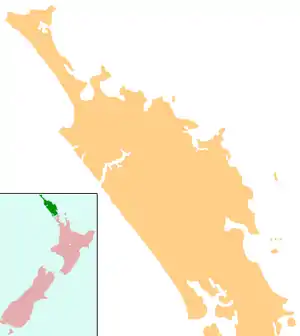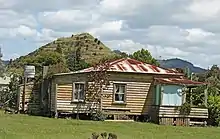Kaeo
Kaeo (Māori: Kāeo) is a township in the Far North District of New Zealand, located some 22 km (14 mi) northwest of Kerikeri. The town takes its name from the kāeo or New Zealand freshwater mussel, which is found in the nearby rivers.
Kaeo
Kāeo (Māori) | |
|---|---|
| Motto(s): Small town, big spirit | |
 Kaeo | |
| Coordinates: 35°6′S 173°47′E | |
| Country | New Zealand |
| Region | Northland Region |
| District | Far North District |
| Postcode | 0478 |
Sanfords Fishery factory, one of the main employers in Kaeo, closed in December 2011.[1]
Demographics
| Year | Pop. | ±% p.a. |
|---|---|---|
| 2006 | 1,077 | — |
| 2013 | 1,005 | −0.98% |
| 2018 | 1,191 | +3.45% |
| Source: [2] | ||
The statistical area of Kaeo, which at 256 square kilometres is much larger than the town, had a population of 1,191 at the 2018 New Zealand census, an increase of 186 people (18.5%) since the 2013 census, and an increase of 114 people (10.6%) since the 2006 census. There were 405 households. There were 624 males and 567 females, giving a sex ratio of 1.1 males per female. Of the total population, 273 people (22.9%) were aged up to 15 years, 192 (16.1%) were 15 to 29, 525 (44.1%) were 30 to 64, and 201 (16.9%) were 65 or older. Figures may not add up to the total due to rounding.
Ethnicities were 65.2% European/Pākehā, 50.9% Māori, 4.3% Pacific peoples, 0.8% Asian, and 1.3% other ethnicities. People may identify with more than one ethnicity.
The percentage of people born overseas was 12.8, compared with 27.1% nationally.
Although some people objected to giving their religion, 52.4% had no religion, 27.7% were Christian, and 11.6% had other religions.
Of those at least 15 years old, 96 (10.5%) people had a bachelor or higher degree, and 210 (22.9%) people had no formal qualifications. The median income was $21,400. The employment status of those at least 15 was that 357 (38.9%) people were employed full-time, 165 (18.0%) were part-time, and 63 (6.9%) were unemployed.[2]
History and culture
Pre-European settlement

Kaeo used to be a fortified village pā of the Ngati Uru sub-tribe. This tribe arrived in the Whangaroa Harbour as late as 1770–1775, having been driven out of the Rawhiti area of the Bay of Islands, after killing and eating Captain Marion du Fresne and his crew.[3]
European settlement
Wesleydale, the first Wesleyan Methodist mission in New Zealand, was established at Kaeo in June 1823, then abandoned in 1827 after it was sacked by local Māori.[4] A memorial cairn marks the site of the mission adjacent to the cemetery on the south side of the Kaeo River.
Flooding
Kaeo is built on the flood plain of the Kaeo River and has experienced destructive flooding. It came to national attention in 2007 when it took the brunt of three major floods within the space of a few months - in February, March and July. Water flooded homes and shops and destroyed the primary school's pool complex. The local rugby clubrooms also suffered, and the club received support from the whole country as it raised funds to lift the clubrooms off the ground to minimise the risk of damage from further flooding.[5]
Landslips, fallen power lines, and road closures resulted from heavy rain in February 2008. The Northland Regional Council scheduled flood-protection work for 2008, but as of 2011 it was still waiting on various consents.[5][6] Floods occurred as a result of Cyclone Wilma in January 2011, and 70 people had to be evacuated from Kaeo.[7]
Marae
The local Waihapa Marae and Te Tai Tokerau meeting house are affiliated with the Ngāti Kahu ki Whangaroa hapū of Riwhi and Te Pania, and the Ngāpuhi / Ngāti Kahu ki Whaingaroa hapū of Ngāti Rangimatamomoe and Whānau Pani.[8][9] In October 2020, the Government committed $180,904 from the Provincial Growth Fund to upgrade Waihapa Marae, creating 12 jobs.[10]
Mangawhero Marae and Te Aroha meeting house are affiliated with the Ngāti Kahu ki Whangaroa hapū of Ngāti Rangimatamomoe and Te Hōia, and the Ngāpuhi / Ngāti Kahu ki Whaingaroa hapū of Kaitore, Ngāti Hōia and Ngāti Rangi.[8][9]
The Kaeo area also has seven other marae affiliated with Ngāpuhi / Ngāti Kahu ki Whaingaroa hapū:
- Mangaiti Marae and Tau te Rangimarie meeting house are affiliated with Ngāti Pākahi and Ngāti Uru
- Mangatōwai Marae is affiliated with Ngāti Aukiwa
- Matangirau Marae and Karangahape meeting house are affiliated with Ngāti Kawau-Kaitangata
- Pupuke Marae and Te Huia meeting house are affiliated with Ngāti Pākahi, Ngāti Uru and Whānau Pani
- Tahawai Marae and Te Awaroa meeting house are affiliated with Tahaawai
- Te Pātūnga Marae and Te Watea meeting house are affiliated with Ngāti Pākahi, Ngāti Uru, Te Aeto and Whānau Pani
- Whakaari Marae is affiliated with Ngāti Kawau[8][9]
Education
Whangaroa College, a coeducational secondary (years 7-15) school,[11] has a roll of 103 students as of March 2020.[12] The principal since 2015 is Jack Anderson.
Kaeo School, a coeducational contributing primary (years 1-6) school,[13] has a roll of 160 students as of March 2020.[12] The school dates from 1877; it moved to its current site some years later. In 1941 it became Kaeo District High School, taking both primary and secondary students. After the opening of Whangaroa College in 1969, Kaeo School became a primary school.[14] The current principal is Paul Barker.
Notable people
Famous people from Kaeo include Eric Rush, New Zealand rugby sevens player and Heather Mansfield of The Brunettes. Rahera Windsor (1925–2004), British Māori spiritual leader and founding member of Ngāti Rānana, was born in Pupuke near Kaeo.[15]
References
- "66 jobs to go at Kaeo oyster plant". The Northern Advocate. 6 December 2011.
- "Statistical area 1 dataset for 2018 Census". Statistics New Zealand. March 2020. Kaeo (101900). 2018 Census place summary: Kaeo
- "The Peopling of the North". Journal of the Polynesian Society. 5 (Supplement). 1896.
- "Wesleyan mission established". New Zealand History. Ministry for Culture and Heritage. 12 January 2018. Retrieved 21 August 2017.
- "Call to stop town flooding a fourth time". The New Zealand Herald. 26 February 2008.
- "Kaeo people frustrated by continual flooding". Radio New Zealand. 31 January 2011. Retrieved 3 February 2011.
- "Wilma departs leaving big clean up". The New Zealand Herald. 29 January 2011.
- "Te Kāhui Māngai directory". tkm.govt.nz. Te Puni Kōkiri.
- "Māori Maps". maorimaps.com. Te Potiki National Trust.
- "Marae Announcements" (Excel). growregions.govt.nz. Provincial Growth Fund. 9 October 2020.
- Education Counts: Whangaroa College
- "New Zealand Schools Directory". New Zealand Ministry of Education. Retrieved 26 April 2020.
- Education Counts: Kaeo School
- "Our school". Kaeo Primary School. Archived from the original on 2007-11-16. Retrieved 2008-01-16.
- Wilson, Susan (22 June 2004). "Rahera Windsor, London Māori leader". London: The Independent.
External links
- Kaeo, Whangaroa Community Development
- Kaeo School website
